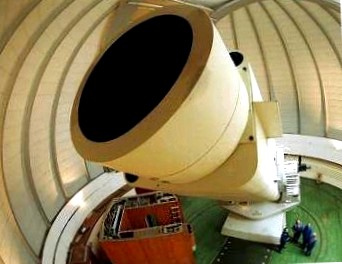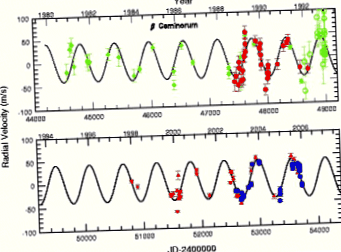Titanic planet around giant star
One of the brightest stars in the winter sky has a planetary companion
Artie hatzes, director of the thuringer landessternwarte tautenburg, has once again located an extrasolar planet with his team. This time it’s a giant gas giant orbiting the massive star pollux. The team that tracked the giant planet includes hatzes, eike guenther, michael hartmann and massimiliano esposito (thuringer landessternwarte tautenburg) and michaela dollinger (european southern observatory).
The thuringian state observatory tautenburg is located about 15 kilometers north of the university town jena and operates the largest optical telescope in germany with a mirror diameter of two meters and last but not least the "tautenburg exoplanet search telescope" (TEST) with a mirror of 30 centimeters. In its operating mode as a schmidt telescope, the 2-meter telescope in thuringen is the coarsest of its kind in the world.

Imposing working instrument: the 2-meter zeiss telescope in tautenburg
Roughest stellar companion
The fact that TEST has also served well in planet hunting in the past is proven by the success rate so far. Finally, the astronomers in tautenburg, under the direction of prof. Dr. Artie hatzes was able to detect several exoplanets with the local equipment, and in early 2005 he was even able to track down an extrasolar planet (HD 13189) from germany for the first time.
The constellation gemini with pollux above the open dome of the tautenburg telescope
Hatzes, who holds a chair in astronomy at the university of jena, has been conducting research in this field since 1988 and has discovered eight extrasolar planets to date. Under his leadership, the search for exoplanets using the radial velocity method became a major focus at the thuringian state observatory.
At least twice the mass of jupiter
Just with this method, hatzes and co. Now another exoplanet found. The celestial body is a giant gas planet 34 light-years from earth orbiting the giant star pollux. Its parent star is more than 30 times brighter than our sun and has 1.7 times the mass of the sun. With at least twice the mass of jupiter, the newly discovered planetary satellite is more massive than any planet in our solar system. To circle its star once, the gas giant needs altogether 590 days.
The giant planet around pollux has twice the mass of jupiter
In 1993, hatzes and his colleagues were able to determine from the data that the lines in the spectrum of pollux shift periodically. At that time, however, hatzes was not yet sure whether the cause of the shifts he observed came from starspots or from an extrasolar planet. Only now, after more than thirteen years of observation, it crystallized that a planet orbits around the star pollux.
Indirect detection
The exoplanet was tracked with the radial velocity method. In this technique, planet hunters focus their attention primarily on the gravitational force of the suspected planet and the resulting small movement of its central star. When the observed star starts to oscillate, its rhythmic shifts can be determined by the change of the radial velocity. If the light of a star is split into spectral colors (like a rainbow), not only colors can be seen, but also spectral lines. These shift as the star wavers.

Temporal representation of the radial velocity quantities
If the star moves minimally towards the earth, the spectral lines appear shifted to the blue light of the optical spectrum, i.E. To the shorter one, whereas in the opposite case the whole shows a small red shift. Thanks to the periodic doppler shift, astronomers can even calculate the change in radial velocity and thus infer the planet’s rough and orbital data.
Shifts of the spectral lines of a star can be caused not only by an orbiting planet, but also by spots and oscillations of the star. In order to find out the reason for the fluctuation, elaborate and above all long-term quantities are necessary, as hatzes and co. Managed with flying colors.
At present the "interactive extra-solar planets catalog" 202 confirmed exoplanets by jean schneider.